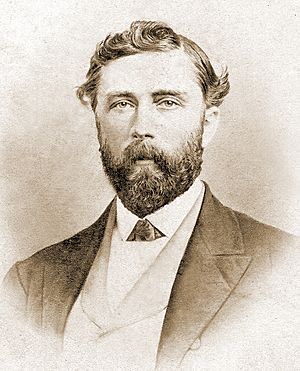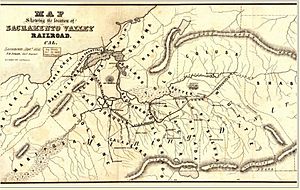Theodore Judah facts for kids
Quick facts for kids
Theodore Judah
|
|
|---|---|

T.D. Judah, c1862, age 36
|
|
| Born |
Theodore Dehone Judah
March 4, 1826 |
| Died | November 2, 1863 (aged 37) New York City, US
|
| Education | Rensselaer Institute in 1837 |
| Occupation | Civil engineer |
| Employer | Central Pacific Railroad |
| Known for | railroad pioneer |
| Title | Chief Engineer, CPRR |
| Spouse(s) | Anna Pierce Judah |
| Signature | |
Theodore Dehone Judah (born March 4, 1826 – died November 2, 1863) was an American engineer. He was very important in planning and building the First Transcontinental Railroad. This was a huge railway that connected the eastern and western parts of the United States.
Judah found people to invest money in the Central Pacific Railroad (CPRR). He was the main engineer and carefully surveyed the land. He found the best path for the railroad to cross the Sierra Nevada mountains. The railroad was finished six years after he died.
Contents
Early Life and Education
Theodore Judah was born in 1826 in Bridgeport, Connecticut. His father, Henry Raymond Judah, was a church leader. When Theodore was young, his family moved to Troy, New York.
In 1837, Judah went to the Rensselaer Polytechnic Institute. Even at a young age, he loved engineering and railroads.
On May 10, 1849, when he was 23, Judah married Anna Pierce. Their wedding was the first in a new church in Greenfield, Massachusetts.
Building Railroads
After studying, Judah worked on several railroads in the Northeast. He helped engineer the Lewiston Railroad. In 1853, he became a member of the American Society of Civil Engineers. At that time, there were fewer than 800 civil engineers in the whole country!
In 1854, Judah became the Chief Engineer for the Sacramento Valley Railroad in California. He and his wife traveled to California by sailing to Nicaragua, crossing land, and then taking a steamer. In 1856, the Sacramento Valley Railroad became the first public railroad built west of the Mississippi River.
Finding the Best Route
In 1857, Judah wrote a plan for building the Pacific Railroad. He said it was important to carefully survey one specific route. Before this, people had only looked at several possible paths generally.
In 1859, Judah went to Washington D.C. to ask for support for the Pacific Railroad. But Congress was busy with problems before the Civil War. They were not very interested. Judah realized he needed to find a clear, practical route. He also needed private money to pay for a detailed survey.
In 1860, he started looking for routes through the Sierra Nevada mountains. He used a special tool called a barometer to measure how high places were. With help from a store owner named Daniel W. Strong, Judah found a good railroad route.
In November 1860, Judah announced his discovery. He found a practical route from Sacramento through Dutch Flat and Donner Pass to the Truckee River. He said this route was the best. It had gentle slopes and was 150 miles shorter than other suggested routes.
Judah became very focused on the Pacific Railroad. His wife said he thought about it day and night. He put all his time, money, and energy into it. People even joked that he was "Judah's Pacific Railroad crazy."
The Central Pacific Railroad
Judah tried to raise money for the railroad in San Francisco. When that didn't work, he found five businessmen in Sacramento. These men were James Bailey, Leland Stanford, Collis P. Huntington, Mark Hopkins, and Charles Crocker.
On June 28, 1861, the Central Pacific Rail Way of California (CPRR) was officially started. Judah became its chief engineer. He surveyed the route over the Sierra Nevada mountains. This was the path the railroad would follow.
In October 1861, Judah went back to Washington D.C. He wanted the government to give land and money to help build the railroad. He worked hard to get a bill passed. On July 1, 1862, President Lincoln signed the Pacific Railroad Act into law. This law gave land and money to the CPRR and the Union Pacific Railroad. This helped them build the transcontinental railroad.
Judah then ordered supplies and sailed back to California. He had achieved his goal in less than a year!
Sad End
Sadly, Judah died on November 2, 1863, from yellow fever. He caught the disease in Panama while traveling to New York City with his wife. He was going to New York to find more money for the railroad.
Anna took his body back to Greenfield, Massachusetts. He was buried there in the Pierce family plot. Theodore Judah died before his dream of a transcontinental railroad was finished.
Lasting Legacy
Just a few days after Judah's death, the CPRR's first train, the Gov. Stanford, made its first test run. It traveled on the new tracks in Sacramento, California.
- The CPRR named one of its steam locomotives, CP No. 4, after him.
- Mount Judah, a mountain in California, was named for him in 1940. It is near Donner Peak in the Sierra Nevada mountains. A long tunnel, called "The Big Hole," runs through the mountain.
- Judah Street in San Francisco and its N-Judah Muni streetcar line are also named after him.
- There are special plaques in Folsom and Sacramento that honor him.
- Elementary schools in Sacramento and Folsom are named after Judah.
Experts say Judah's engineering work was amazing. He used simple tools and animals to survey a very difficult route. It was one of the hardest projects of its kind at that time.
See also
 In Spanish: Theodore Judah para niños
In Spanish: Theodore Judah para niños



